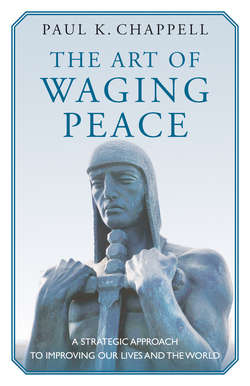Читать книгу The Art of Waging Peace - Paul K. Chappell - Страница 24
На сайте Литреса книга снята с продажи.
ОглавлениеCHAPTER 5
The Three Forms of Deflection
Social Norms
To create societal change we don’t have to convince every single person that a cause is justified, fair, and reasonable. We only have to convince enough people. For example, was every single man in America convinced women should have the right to vote? No, and there are still men in America who don’t think women should have the right to vote. Was every single white person in America convinced slavery and segregation should go away? No, and there are still white people in America who want slavery and segregation to come back.
When any form of positive change is concerned, it is impossible to convince everyone it should happen. As I explain in Peaceful Revolution, many people have not developed their empathy, conscience, reason, and the other muscles of our humanity that encourage us to work for positive change. And as I explain in The End of War, the human brain is the most complex thing we know of in the universe, and our extremely complex brains make us vulnerable to a wide variety of mental disorders that can inhibit our empathy, conscience, and reason.
During my lectures around the country I often talk to diverse groups. When I speak with a group of fifty people and mention how the women’s rights movement greatly inspires me, I realize there might be one or two people in the audience who wish women never gained the right to vote. Two out of fifty is only 4 percent of the audience. That might seem like a tiny percentage, but what if 4 percent of the American population believed women should not have the right to vote? How many would that be? As I write this the American population is around 300 million, and 4 percent of that is a whopping 12 million. In fact, if just one out of every thousand Americans believed women should not have the right to vote, that would still be 300,000.
Many people today who oppose women’s and civil rights would never say it in public, because women’s and civil rights have now become social norms. What is a social norm, and how does it work? A social norm occurs when a new idea has persuaded enough people to create a new public consensus. To better understand this, imagine a white man who works in a typical office in America—one that has women and people of various racial backgrounds. Now imagine him standing up and yelling, “No woman should be allowed to vote! All niggers should be slaves!” He would not only alienate the women and African Americans in his office, but also most of his white male coworkers because our society has begun to view racists and sexists as ignorant, closed-minded, and hateful. In addition to alienating his coworkers, he would probably get fired and might even get beaten up.
Now imagine if two hundred years ago in America someone shouted in public, “No woman should be allowed to vote! All niggers should be slaves!” This statement would have received little opposition and a lot of applause, because the modern social norms of women’s and civil rights did not exist back then. To understand how influential social norms are, do you know what President George W. Bush considers the worst moment of his presidency? Was it when our country was attacked on September 11? Was it when the torture committed by American soldiers at Abu Ghraib prison in Iraq was exposed? Was it when Hurricane Katrina devastated New Orleans and other cities? No. President Bush said the worst moment of his presidency was when rapper Kanye West called him a racist. President Bush explains:
At an NBC telethon to raise money for Katrina victims, rapper Kanye West told a primetime TV audience, “George Bush doesn’t care about black people . . . ” Five years later, I can barely write those words without feeling disgusted . . . The more I thought about it, the angrier I felt. I was raised to believe that racism was one of the greatest evils in society. I admired Dad’s courage when he defied near-universal opposition from his constituents to vote for the Open Housing Bill of 1968. I was proud to have earned more black votes than any Republican governor in Texas history. I had appointed African Americans to top government positions, including the first black woman national security advisor and the first two black secretaries of state . . . The suggestion that I was a racist because of the response to Katrina represented an all-time low. I told Laura at the time that it was the worst moment of my presidency. I feel the same way today.1
I am including this story from President Bush for one reason only: to illustrate how the worst thing we can call somebody today is a racist. Several hundred years ago the idea of being a racist didn’t really exist. Imagine if time travel were possible and you went back to the eighteenth century. If you called a white person back then a racist, he would likely ask, “What does that mean?” If you said, “It means you think all white people are superior to black people just because they’re white,” he would probably reply, “Of course we’re superior to black people! We’re white!” Today the public consensus toward racism has changed, and it is simply not cool to openly be a racist anymore.
